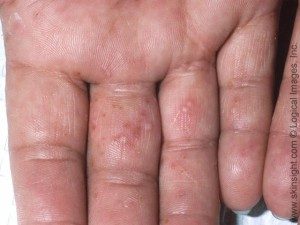Research Trend Report: Why More Eczema Patients are Turning to…
Learn what’s new and exciting in eczema research from the National Eczema Association research team.

Published On: Feb 15, 2018
Last Updated On: Feb 20, 2025
Joan Wanamaker has lived with eczema practically since birth. She’s had all the various subtypes, co-occurring at different times in her life, with hand eczema being her constant (yet unwanted) companion.
“A few years ago, my doctor told me it’s dyshidrotic eczema,” Wanamaker said. “He prescribed a succession of different creams, and eventually a topical steroid worked.”
With all the recent advances in eczema research, treating dyshidrotic eczema is still pretty much hit-or-miss, according to Dr. Elaine Siegfried, a professor of pediatrics and dermatology at Saint Louis University School of Medicine in St. Louis. She believes dyshidrotic eczema is the least understood of the condition’s many subtypes.
subtypes.
Even its name creates confusion: “The term dyshidrotic means ‘disordered sweat.’ It was first coined in the late 19th century, reflecting the belief that a malfunction of the sweat glands in the hands caused this type of eczema. Today, we know that sweat may trigger the itch-scratch cycle, but it doesn’t actually cause eczema,” Siegfried explained.
Dyshidrotic eczema goes by several other names, such as palmoplantar eczema, foot-and-hand eczema, vesicular eczema and pompholyx. This last term comes from the Ancient Greek word for “bubble.”
That’s what the condition’s characteristically small blisters looked like to our forebears-and the name stuck. It’s still used today, but dyshidrotic eczema is the most common term for the small, itchy blisters that appear on the edges of the fingers as well as the palms of the hands and soles of the feet, often quite suddenly.
At their most severe, the blisters can be painful and even crippling. As a child at summer camp, Wanamaker developed them on her feet. “It was painful to walk,” she said, “and it took all summer for them to clear up. Apparently, I had an allergic reaction to the chemicals in the swimming pool. What’s puzzling is that the very next year, I had no problem with the pool chemicals. Over the years, my triggers have changed.”
Still, knowing and avoiding your triggers remains the first line of defense against dyshidrotic eczema.
An overview of dyshidrotic eczema on Medscape estimates that close to 50 percent of those who develop dyshidrotic eczema already have atopic dermatitis (AD), making already existing eczema a leading risk factor. Clearly, explained Siegfried, there’s a genetic component to the condition.
Adult females between ages 20 and 40 are at particular risk. However, many triggers of dyshidrotic eczema fall into the “manageable” category, including nickel, cobalt, balsam and bacterial or fungal infection, with nickel considered the prime suspect.
“Some doctors believe that an allergy to nickel is the principal cause of dyshidrotic eczema,” Siegfried said, given the high levels of nickel in sweat and the concentration of sweat glands in the palms and soles of the feet.
“There’s no consensus yet among experts about this, but patients can test the nickel hypothesis by consulting a nutritionist and trying a nickel-free diet for six weeks to see if it helps clear the blisters.”
Avoiding such everyday objects as nickel-rich coins, zippers, cellphones, belt buckles and eyeglass frames can also help to confirm or rule out nickel as a trigger in some people with the condition.
Dyshidrotic eczema is also strongly linked to seasonal allergies, especially to changes in humidity. It normally takes six weeks for the body to adapt to seasonal change, said Siegfried. And by the time a person adapts, the season might start changing again.
That doesn’t mean patients should throw up their hands and give up. The most important step is to get a proper diagnosis.
“Dyshidrotic eczema can mimic contact dermatitis and even palmoplantar pustulosis, a type of psoriasis appearing on the hands and feet,” said Siegfried. “The only way to tell which is which is with a biopsy. Without a definitive diagnosis, patients could receive suboptimal treatment.”
On the positive side of the line, people with the condition have several options. In addition to avoiding triggers, Siegfried pointed to the following treatments and their limitations. “Topical corticosteroid cream can be helpful as a quick-acting remedy,” she said.
“Think of it as the ‘hare’ in the fable of ‘The Tortoise and the Hare.’ It may get quick results, but it can also weaken the skin over time, leading to a cycle of flare and remission.It’s best to switch to another therapy after a couple of weeks, such as a topical calcineurin inhibitor or phototherapy.”
Over the years, Wanamaker has tried all these and more. Her grandmother used to create a paste from cornstarch and water and apply it to her young granddaughter’s hands—a home remedy that brought short-term relief for her itchy skin.
As an adult, Wanamaker remains open to “exploring and experimenting” with a variety of options, from nutrition to natural cleaning products. She and her husband enjoy making their own soap, shampoo and laundry detergent, using tallow and local plants found near their home in Orange County, New York, during the summer.
And they’re hopeful that better treatments are on the way. We’re at the dawn of the “decade of eczema,” as Siegfried sees it. With all the medications in the pipeline for AD, can dyshidrotic eczema be far behind?
 Elaine Siegfried, MD is a member of NEA’s Scientific Advisory Committee and Director of Pediatric Dermatology at SSM Health Cardinal Glennon Children’s Hospital. She is board certified by the American Board of Dermatology in both Dermatology and Pediatric Dermatology. She is also a Professor of Pediatrics and Dermatology at Saint Louis University School of Medicine.
Elaine Siegfried, MD is a member of NEA’s Scientific Advisory Committee and Director of Pediatric Dermatology at SSM Health Cardinal Glennon Children’s Hospital. She is board certified by the American Board of Dermatology in both Dermatology and Pediatric Dermatology. She is also a Professor of Pediatrics and Dermatology at Saint Louis University School of Medicine.